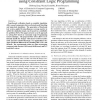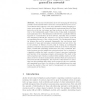128 search results - page 5 / 26 » When the a contrario approach becomes generative |
BMCBI
2010
13 years 7 months ago
2010
Background: ChIP-Seq, which combines chromatin immunoprecipitation (ChIP) with high-throughput massively parallel sequencing, is increasingly being used for identification of prot...
GLVLSI
2002
IEEE
14 years 12 days ago
2002
IEEE
Design simplification is becoming necessary to respect the target time-to-market of SoCs, and this goal can be obtained by using predesigned IP-cores. However, their correct inte...
IFIP
2001
Springer
13 years 12 months ago
2001
Springer
— Semi-formal verification based on symbolic simulation offers a good compromise between formal model checking and numerical simulation. The generation of functional test vector...
WAC
2004
Springer
14 years 24 days ago
2004
Springer
The amount of information in the new emerging all-embracing pervasive environments will be enormous. Current Internet protocol conceived almost forty years ago, were never planned ...
CONTEXT
2003
Springer
14 years 20 days ago
2003
Springer
Abstract. The knowledge representation tradition in computational lexicon design represents words as static encapsulations of purely lexical knowledge. We suggest that this view po...



